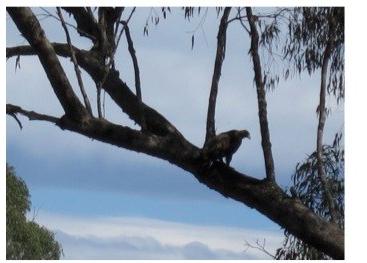 An eagle spotted on my way to Tubbut a few years ago.
An eagle spotted on my way to Tubbut a few years ago.
I am still reeling from the news which exploded across my Facebook yesterday –
100 wedge-tailed eagles found dead at Tubbut in East Gippsland
Oh no …. This last sanctuary for wildlife, with its many hectares of national parks and untracked craggy hills. Where, even after the last devastating fire, the wombats and wallabies are returning because where else can they go?
The eagles have long soared above these hills. They don’t know it, but their right to do so is legislated and they should feel the safer for it.
It turns out that, in our area they have had no reason to feel safe.
Settler Australians have a poor record of ‘caring’ for the bush. In they came with their cattle, sheep and horses and everything seen as a threat to their commercial activities was soon removed by whatever means necessary.
The carnage started with the First Fleet. The tendency to regard all wildlife as threatening regardless of evidence was noted in the media in 1910.
“An eagle found on a dead sheep is supposed even by experienced bushmen to have killed the animal. Part of the persecution the bird suffers arises from that misapprehension. All anyone need do to dissipate the notion is to examine a dead eagle’s talons and muscles. It drives in its talons, and with small prey crushes life out immediately, occasionally using its beak to tear. But it must rely upon the talons to carry the prey.
The eagle is not a ground feeder, except where the animal is carrion — a sheep or a bullock— and too big to carry away to a high tree. Even a moderate-sized lamb is too heavy for such holding capacity. But the bad character has gone abroad, and the real delinquencies of the bird have been exaggerated and multiplied until human murders are cited against it. Our wedge-tailed eagle has to carry some of the bad reputation of the eagle of the Alps, though it has long been known that the latter bird’s evil character is largely due to the imagination either of simple peasants or sensational fictionists. Kill him, therefore, has been the cry since the beginning of settlement. Indeed, before occupation actually began, the white man looked on it as a creature to be slaughtered. Sir Joseph Banks, who, with Captain Cook, went ashore on a small island, called by them Eagle Island, shot many of the birds. Sir Joseph remarks in one place: ‘We found the nest of an eagle, the young ones of which were killed.'”
The methods have become even more effective, involving tricking the birds into their own death. If, as in this case, more than 100 eagles were killed by the tried and true method of baiting a sheep carcass with poison, there must be a huge dent in the local population of eagles. This is carnage at a staggering scale. For the sake of a few lambs, kept in a paddock distant from human oversight. Shepherds were employed by the early squatters of the Monaro to safeguard their sheep. Not a great gig and often the only men available were ex-convicts and ticket-of-leave men and they are our forefathers.
Since then we have seen the demise of the koala from the Tubbut-Delegate River-Bonang area. A bounty was placed upon them due to the value of their fur which was fashionable in the streets of London in the 1920s and favoured by anyone who had to travel to the Arctic. The native cat or tiger quoll has all but disappeared for a variety of reasons, all human-related.
When we first came to this area in 1971 we were treated to the sight of a wedge-tailed eagle pinned to a fence in Tubbut. It gave us a general idea of the local attitude to wildlife at the time. In my first week in the area, I wrote a letter to the editor of the Bombala Times in response to an article that boasted about the number of wombat the dog-trapper had caught. It was beyond me that this creature would be seen as a pest and that the government would sanction its death in large numbers in this painful way. I didn’t save the wombat and my credentials as a greenie were established early in my residency. Before then all greenies were assumed to be city-based.
We do live in more enlightened times as the evidence mounts up about our disappearing species. The eagle was not endangered in Victoria yesterday but, for sure, the loss of so many must take them closer to the brink.
Great article Deb. Such a tragedy to hear about the loss of so many of our glorious eagles. Are you interested in doing a radio ABC interview on Tuesday> For the drive program. They rang me on Thursday or Friday. I think it would be better coming from a local. This deliberate massacre is unforgivable and the punishment should fit the crime. Evidently it was not only eagles killed.
LikeLike
Hi Susie, thanks for nice comments. Wonder if Drive would want to speak to me, they spoke to me Thursday, mightn’t have liked me! DELWP will have done its media conference by then? Assumedly I could get access to their statement?
LikeLike